What's inside
What's inside
 Key Ingredients
Key Ingredients

 Benefits
Benefits

 Concerns
Concerns

 Ingredients Side-by-side
Ingredients Side-by-side

Water
Skin ConditioningRosa Damascena Flower Water
MaskingGlycerin
HumectantPropanediol
SolventIsohexadecane
EmollientAcrylamide/Sodium Acryloyldimethyltaurate Copolymer
Emulsion StabilisingSodium Hyaluronate
HumectantPanthenol
Skin ConditioningAllantoin
Skin ConditioningSymphytum Officinale Root Extract
Skin ConditioningXylitylglucoside
HumectantBetaine
HumectantAnhydroxylitol
HumectantXylitol
HumectantAmmonium Polyacryloyldimethyl Taurate
Emulsion StabilisingEthylhexylglycerin
Skin ConditioningPolysorbate 80
EmulsifyingSorbitan Oleate
EmulsifyingBenzoic Acid
MaskingCitric Acid
BufferingSodium Hydroxide
BufferingPotassium Sorbate
PreservativeSodium Benzoate
MaskingGeraniol
PerfumingCitronellol
PerfumingWater, Rosa Damascena Flower Water, Glycerin, Propanediol, Isohexadecane, Acrylamide/Sodium Acryloyldimethyltaurate Copolymer, Sodium Hyaluronate, Panthenol, Allantoin, Symphytum Officinale Root Extract, Xylitylglucoside, Betaine, Anhydroxylitol, Xylitol, Ammonium Polyacryloyldimethyl Taurate, Ethylhexylglycerin, Polysorbate 80, Sorbitan Oleate, Benzoic Acid, Citric Acid, Sodium Hydroxide, Potassium Sorbate, Sodium Benzoate, Geraniol, Citronellol
Glycerin
HumectantWater
Skin ConditioningSodium Cocoyl Glycinate
CleansingButylene Glycol
HumectantSqualane
EmollientStearic Acid
CleansingDiheptyl Succinate
EmollientButyrospermum Parkii Butter
Skin ConditioningVitis Vinifera Seed Oil
EmollientShea Butter Ethyl Esters
EmollientCapryloyl Glycerin/Sebacic Acid Copolymer
Skin ConditioningAvena Sativa Kernel Oil
Skin ConditioningSimmondsia Chinensis Seed Oil
EmollientAdansonia Digitata Seed Oil
EmollientCitrullus Lanatus Seed Oil
EmollientArgania Spinosa Kernel Oil
EmollientHelianthus Annuus Seed Oil
EmollientRosmarinus Officinalis Leaf Extract
AntimicrobialFicus Carica Fruit Extract
HumectantAgastache Mexicana Flower/Leaf/Stem Extract
Skin ConditioningAvena Sativa Kernel Extract
AbrasiveAdansonia Digitata Fruit Extract
EmollientAloe Barbadensis Leaf Juice
Skin ConditioningSodium Hyaluronate
HumectantPolyglyceryl-10 Laurate
Skin ConditioningHydroxyethylcellulose
Emulsion StabilisingCocamidopropyl Betaine
CleansingSodium Lauroyl Methyl Isethionate
CleansingSodium Methyl Oleoyl Taurate
CleansingPropanediol
SolventGluconolactone
Skin ConditioningCoco-Glucoside
CleansingLauryl Glucoside
CleansingOctyldodecanol
EmollientPropylene Glycol
HumectantOctyldodecyl Xyloside
EmulsifyingGlyceryl Caprylate
EmollientGlyceryl Undecylenate
EmollientPhospholipids
Skin ConditioningXanthan Gum
EmulsifyingPEG-30 Dipolyhydroxystearate
EmulsifyingPolyglyceryl-10 Dioleate
EmulsifyingPolyglyceryl-10 Oleate
Skin ConditioningPolyglyceryl-2 Isostearate
EmulsifyingCalcium Gluconate
HumectantPEG-60 Hydrogenated Castor Oil
EmulsifyingDisodium Sebacoyl Bis-Lauramidolysine
Skin ConditioningDisodium Phosphate
BufferingPolysorbate 60
EmulsifyingSodium Phosphate
BufferingSodium Citrate
BufferingSodium Benzoate
MaskingPotassium Sorbate
PreservativeGlycerin, Water, Sodium Cocoyl Glycinate, Butylene Glycol, Squalane, Stearic Acid, Diheptyl Succinate, Butyrospermum Parkii Butter, Vitis Vinifera Seed Oil, Shea Butter Ethyl Esters, Capryloyl Glycerin/Sebacic Acid Copolymer, Avena Sativa Kernel Oil, Simmondsia Chinensis Seed Oil, Adansonia Digitata Seed Oil, Citrullus Lanatus Seed Oil, Argania Spinosa Kernel Oil, Helianthus Annuus Seed Oil, Rosmarinus Officinalis Leaf Extract, Ficus Carica Fruit Extract, Agastache Mexicana Flower/Leaf/Stem Extract, Avena Sativa Kernel Extract, Adansonia Digitata Fruit Extract, Aloe Barbadensis Leaf Juice, Sodium Hyaluronate, Polyglyceryl-10 Laurate, Hydroxyethylcellulose, Cocamidopropyl Betaine, Sodium Lauroyl Methyl Isethionate, Sodium Methyl Oleoyl Taurate, Propanediol, Gluconolactone, Coco-Glucoside, Lauryl Glucoside, Octyldodecanol, Propylene Glycol, Octyldodecyl Xyloside, Glyceryl Caprylate, Glyceryl Undecylenate, Phospholipids, Xanthan Gum, PEG-30 Dipolyhydroxystearate, Polyglyceryl-10 Dioleate, Polyglyceryl-10 Oleate, Polyglyceryl-2 Isostearate, Calcium Gluconate, PEG-60 Hydrogenated Castor Oil, Disodium Sebacoyl Bis-Lauramidolysine, Disodium Phosphate, Polysorbate 60, Sodium Phosphate, Sodium Citrate, Sodium Benzoate, Potassium Sorbate
 Reviews
Reviews

Ingredients Explained
These ingredients are found in both products.
Ingredients higher up in an ingredient list are typically present in a larger amount.
Glycerin is already naturally found in your skin. It helps moisturize and protect your skin.
A study from 2016 found glycerin to be more effective as a humectant than AHAs and hyaluronic acid.
As a humectant, it helps the skin stay hydrated by pulling moisture to your skin. The low molecular weight of glycerin allows it to pull moisture into the deeper layers of your skin.
Hydrated skin improves your skin barrier; Your skin barrier helps protect against irritants and bacteria.
Glycerin has also been found to have antimicrobial and antiviral properties. Due to these properties, glycerin is often used in wound and burn treatments.
In cosmetics, glycerin is usually derived from plants such as soybean or palm. However, it can also be sourced from animals, such as tallow or animal fat.
This ingredient is organic, colorless, odorless, and non-toxic.
Glycerin is the name for this ingredient in American English. British English uses Glycerol/Glycerine.
Learn more about GlycerinPotassium Sorbate is a preservative used to prevent yeast and mold in products. It is commonly found in both cosmetic and food products.
This ingredient comes from potassium salt derived from sorbic acid. Sorbic acid is a natural antibiotic and effective against fungus.
Both potassium sorbate and sorbic acid can be found in baked goods, cheeses, dried meats, dried fruit, ice cream, pickles, wine, yogurt, and more.
You'll often find this ingredient used with other preservatives.
Learn more about Potassium SorbatePropanediol is an all-star ingredient. It softens, hydrates, and smooths the skin.
It’s often used to:
Propanediol is not likely to cause sensitivity and considered safe to use. It is derived from corn or petroleum with a clear color and no scent.
Learn more about PropanediolSodium Benzoate is a preservative. It's used in both cosmetic and food products to inhibit the growth of mold and bacteria. It is typically produced synthetically.
Both the US FDA and EU Health Committee have approved the use of sodium benzoate. In the US, levels of 0.1% (of the total product) are allowed.
Sodium benzoate works as a preservative by inhibiting the growth of bacteria inside of cells. It prevents the cell from fermenting a type of sugar using an enzyme called phosphofructokinase.
It is the salt of benzoic acid. Foods containing sodium benzoate include soda, salad dressings, condiments, fruit juices, wines, and snack foods.
Studies for using ascorbic acid and sodium benzoate in cosmetics are lacking, especially in skincare routines with multiple steps.
We always recommend speaking with a professional, such as a dermatologist, if you have any concerns.
Learn more about Sodium BenzoateSodium Hyaluronate is hyaluronic acid's salt form. It is commonly derived from the sodium salt of hyaluronic acid.
Like hyaluronic acid, it is great at holding water and acts as a humectant. This makes it a great skin hydrating ingredient.
Sodium Hyaluronate is naturally occurring in our bodies and is mostly found in eye fluid and joints.
These are some other common types of Hyaluronic Acid:
Learn more about Sodium HyaluronateWater. It's the most common cosmetic ingredient of all. You'll usually see it at the top of ingredient lists, meaning that it makes up the largest part of the product.
So why is it so popular? Water most often acts as a solvent - this means that it helps dissolve other ingredients into the formulation.
You'll also recognize water as that liquid we all need to stay alive. If you see this, drink a glass of water. Stay hydrated!
Learn more about Water